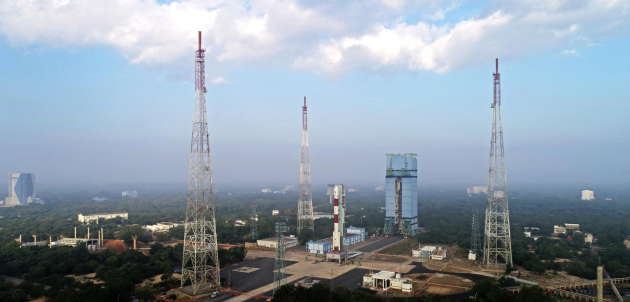India will begin 2024 with the launch of an X-ray astronomy satellite aboard the sixtieth flight of its Polar Satellite Launch Vehicle. The PSLV C58 mission is due to lift off at 9:10 AM local time (03:40 UTC) on Monday, Jan. 1, from the Satish Dhawan Space Centre.
XPoSat, or X-ray Polarimeter Satellite, carries a pair of instruments that will be used to study X-ray emissions from astronomical sources. After deploying XPoSat, PSLV C58’s upper stage will remain in orbit as the third flight of the PSLV Orbital Experimental Module (POEM-3), serving as a free-flying platform hosting a range of attached payloads.
Monday’s launch is targeting a near-equatorial low-Earth orbit at an altitude of about 650 kilometers and an inclination of six degrees for the deployment of XPoSat. After the primary payload has separated, the upper stage will lower its orbit to about 350 kilometers and increase its inclination to 9.6 degrees to conduct the POEM-3 mission.
XPoSat is the first mission to be launched by the Indian Space Research Organisation (ISRO) to study x-ray polarimetry — the level and average angle of polarisation of x-rays detected from interstellar sources. Measuring the polarity of x-rays from black hole binary systems, neutron stars and magnetars, active galactic nuclei, pulsars, and other sources of emissions, will gather more data to help scientists understand the complex processes that take place within these phenomena.
The satellite carries two instruments, the Polarimeter Instrument in X-rays (POLIX) and X-ray Spectroscopy and Timing (XSPECT). XPoSat has a total mass of 469 kilograms and is expected to operate for at least five years. Its key objectives are to measure the polarisation of X-rays from about 50 sources; to make long-term observations of spectral changes over time of cosmic X-ray sources; and to make combined observations at the energy bands where its instruments overlap.
It is similar in mission to NASA’s Imaging X-ray Polarimetry Explorer (IXPE), launched in December 2021.
POLIX was developed by the Raman Research Institute (RRI) and ISRO’s U R Rao Satellite Centre (URSC). It uses a collimator to try to limit its field of view to a single bright X-ray source at a time. X-rays that pass through the collimator reach the scatterer, where they will transfer energy to electrons in a process known as Thompson scattering. Four detectors around the scatterer will measure the scattered X-rays, inferring their polarity by recording the direction in which they were scattered. By repeating these observations for many incident X-rays, this process can determine the amount and average direction of polarisation.
The POLIX instrument is designed to study medium-energy x-rays, with energies between eight and 30 kilo-electronvolts. XSPECT is an X-ray spectrometer that will support POLIX’s observations by monitoring changes in the X-ray emission spectra of the objects being observed, as well as fulfilling the mission’s objective of carrying out long-term spectral studies. Built by URSC, XSPECT will study x-rays at energies between 0.8 and 15 kilo electronvolts.
XPoSat before integration with the launch vehicle. (Credit: ISRO)
Once XPoSat has been deployed, and PSLV’s upper stage has repositioned and passivated itself, the stage will serve as an orbiting experimental platform, POEM-3. To support this role, the stage is equipped with solar panels to generate power and a number of non-deployable research payloads. Ten payloads have been announced, with three to be operated by ISRO and the rest coming from other research institutions or private industry.
ISRO’s payloads aboard POEM-3 include the Dust Experiment (DEX) to measure levels of interplanetary dust in low-Earth orbit, the Fuel Cell Power System (FPCS) which will test a fuel cell in orbit for power generation, and a silicon-based high-energy power cell. Two payloads for Bellatrix Aerospace: RUDRA 0.3 HPGP and ARKA-200, will test a new monopropellant thruster using environmentally friendly propellants and a new type of hall-effect thruster.
Inspecity Space also has a propulsion experiment aboard POEM-3: the Green Impulse Transmitter (GITA) will demonstrate a bipropellant thruster using green propellants. Dhruva Space’s LEAP-TD (Launching Expeditions for Aspiring Technologies – Technology Demonstrator) will test systems for future small-satellite missions, while TakeMe2Space’s Radiation Shielding Experimental Module (RSEM) will study the use of tantalum coating to protect satellite components from radiation.
BeliefSat-0 is an amateur radio payload being carried for the K J Somaiya Institute of Technology, and the Women Engineered Satellite (WESAT) from the LBS Institute of Technology for Women will carry out a solar research mission.

A PSLV-DL at the launch pad ahead of a previous mission, PSLV C49 in November 2020. (Credit: ISRO)
ISRO will use its workhorse Polar Satellite Launch Vehicle (PSLV) rocket to deploy XPoSat. First launched in September 1993, PSLV will be making its sixtieth flight with Monday’s C58 mission. Of its previous 59 launches, 56 have been completed successfully with two failures and one partial failure. The most recent unsuccessful launch was in August 2017, when the rocket’s payload fairing failed to separate resulting in the loss of the IRNSS-1H navigation satellite. Since then, PSLV has flown 18 consecutive successful missions, with September’s deployment of the Aditya-L1 solar research satellite its most recent outing.
PSLV is a four-stage rocket, which uses a mixture of solid and liquid propellant on different stages. To tailor its performance to differing mission requirements, it can fly with zero, two, four, or six solid rocket motors boosting the first stage, with these configurations designated PSLV-CA, PSLV-DL, PSLV-QL, and PSLV-XL respectively. The original PSLV configuration, which used six smaller boosters, is known as PSLV-G, however this has not flown since 2016.
Monday’s launch will use the PSLV-DL configuration, with a pair of PS0M-XL boosters, with S-12 solid rocket motors, attached to the first stage. The first stage itself — designated PS1 — has an S139 solid-propellant motor. All of PSLV’s solid-fuelled components burn a hydroxyl-terminated polybutadiene (HTPB) compound.
PSLV will lift off from the First Launch Pad (FLP) at ISRO’s Satish Dhawan Space Centre (SDSC) on Sriharikota, a barrier island on India’s east coast, to the north of Chennai. The FLP is the oldest of two active launch pads at SDSC, having first been used in 1993 for PSLV’s maiden flight. PSLV can fly from either FLP or the newer Second Launch Pad located about 1.6 kilometers to the south.
The First Launch Pad has a mobile service tower (MST) to support the integration of rockets in-situ at the pad, however, the completion of the new PSLV Integration Facility (PIF), which supported its first mission in April 2023, allows the lower stages of a second rocket to be built up away from the pad so two launch campaigns can be carried out in parallel. The first and second stages of PSLV C58 were stacked atop a mobile launch platform within the PIF, with the boosters also being attached to the first stage before rollout to the launch pad. The third and fourth stages, payload and payload fairing were added to the rocket once it was in position on the pad.

SDSC, with FLP in the foreground, SLP in the background, and PIF far right. The rocket arriving at FLP is PSLV C55, launched in April 2023. (Credit: ISRO)
The PSLV C58 mission will begin with the ignition of the first stage roll control thrusters (RCTs) about three seconds before the zero mark in the countdown. The first stage will light at T0, with the two PS0M-XL motors igniting 0.42 seconds later. PSLV will lift off and maneuver to an azimuth of 102 degrees taking it east over the Bay of Bengal. The next major event in the flight will be burnout and separation of the PS0M-XL boosters, expected around 70 seconds after liftoff.
After the boosters separate, PSLV’s first stage will continue to burn for another 40 seconds. Two-tenths of a second after the first stage is jettisoned, the second stage will ignite to continue the climb toward orbit. PSLV’s second stage is designated PS2, or PL40(HP), and uses liquid propellants: UH25 propellant (one part hydrazine hydrate to three parts unsymmetrical dimethylhydrazine) oxidized by dinitrogen tetroxide. Its Vikas engine is a license-built derivative of the French Viking engine that powered early members of the European Ariane family of rockets.
The second stage burn is expected to last about two and a half minutes, with two major flight events occurring during the burn. About five seconds after ignition the rocket will switch to closed-loop guidance. Just over a minute later, after PSLV has reached space, the payload fairing will separate from the nose of the vehicle. Termed a “heat shield” by ISRO, the fairing protects the rocket’s payload during the climb through the dense lower regions of Earth’s atmosphere and maintains the vehicle’s aerodynamic profile.
At four minutes, 21.5 seconds mission elapsed time, PSLV’s second stage will separate. The HPS3 third stage will ignite its solid-fuelled S-7 motor 1.2 seconds later, beginning an approximately 70-second burn. After burnout, the third stage will initially remain attached as the mission enters an unpowered coast phase, climbing to the apogee — or highest point — of the trajectory. The spent third stage will be jettisoned around the nine-minute, 46-second mark in the flight, with fourth stage ignition timed for around T+16 minutes and 51 seconds.

Timeline for the PSLV C58 mission. (Credit: ISRO)
PSLV’s fourth stage — designated PS4 or L1.6(Ti) — has two small liquid-propellant thrusters burning monomethylhydrazine and mixed oxides of nitrogen (MON-3, consisting of three parts nitric oxide to 97 parts dinitrogen tetroxide). Its first burn will last four minutes and 7.5 seconds, inserting XPoSat into its planned low-Earth orbit. Spacecraft separation will take place 57 seconds later. Once XPoSat has been deployed, the fourth stage will make two additional burns to lower its orbit and increase its inclination for the POEM-3 mission. Any leftover oxidizer will be vented through the engines, followed by fuel, to passivate the stage’s propulsion system and reduce the risk of an explosion in orbit during the extended mission.
If Monday’s launch takes place as scheduled, it will be the first to be conducted on New Year’s Day at the launch site. The maiden Commercial Titan III launch occurred at 00:08 UTC on Jan. 1, 1990 — however, it was still Dec. 31 at Cape Canaveral when it took place. The two days, three hours, and 27 minutes between Saturday’s Chang Zheng 2C launch from China and Monday’s PSLV liftoff will also be the shortest gap recorded to date between the last launch of a calendar year and the first of the next year.
India carried out seven orbital launches in 2023 and will be looking ahead to a busy year in 2024 as the country continues to expand its space program and moves closer to developing human spaceflight capabilities. An uncrewed orbital test flight of the Gaganyaan spacecraft is expected to take place later this year ahead of a first crewed mission in 2025.
India’s next launch is currently scheduled for Jan. 20, with a Geosynchronous Satellite Launch Vehicle Mk.II (GSLV Mk.II) due to carry the INSAT-3DS communications satellite into orbit. The date and payload for the next PSLV launch have not yet been announced.
(Lead image: PSLV C58 with XPoSat at the launch pad. Credit: ISRO)





